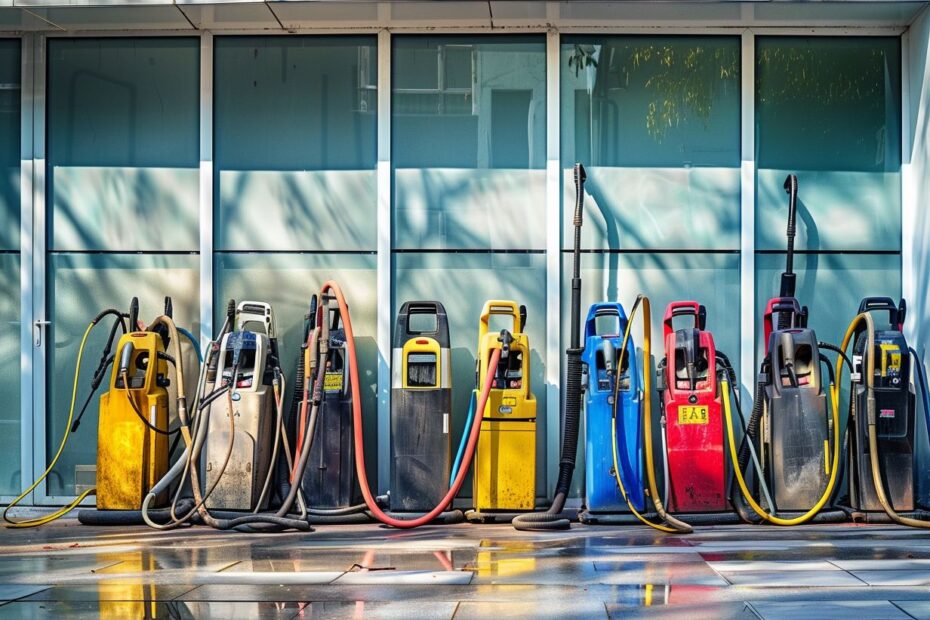Pressure washers are powerful cleaning tools that can make light work of tough grime and dirt on exterior facades.
We will explore the different types of pressure washers, key features to consider when choosing one, safety precautions for use, how they can be utilized on various exterior surfaces, and tips for maintenance and storage.
Knowing how to select and use a pressure washer effectively is essential when cleaning brick, wood, vinyl, concrete, or stucco.
What Are Pressure Washers?
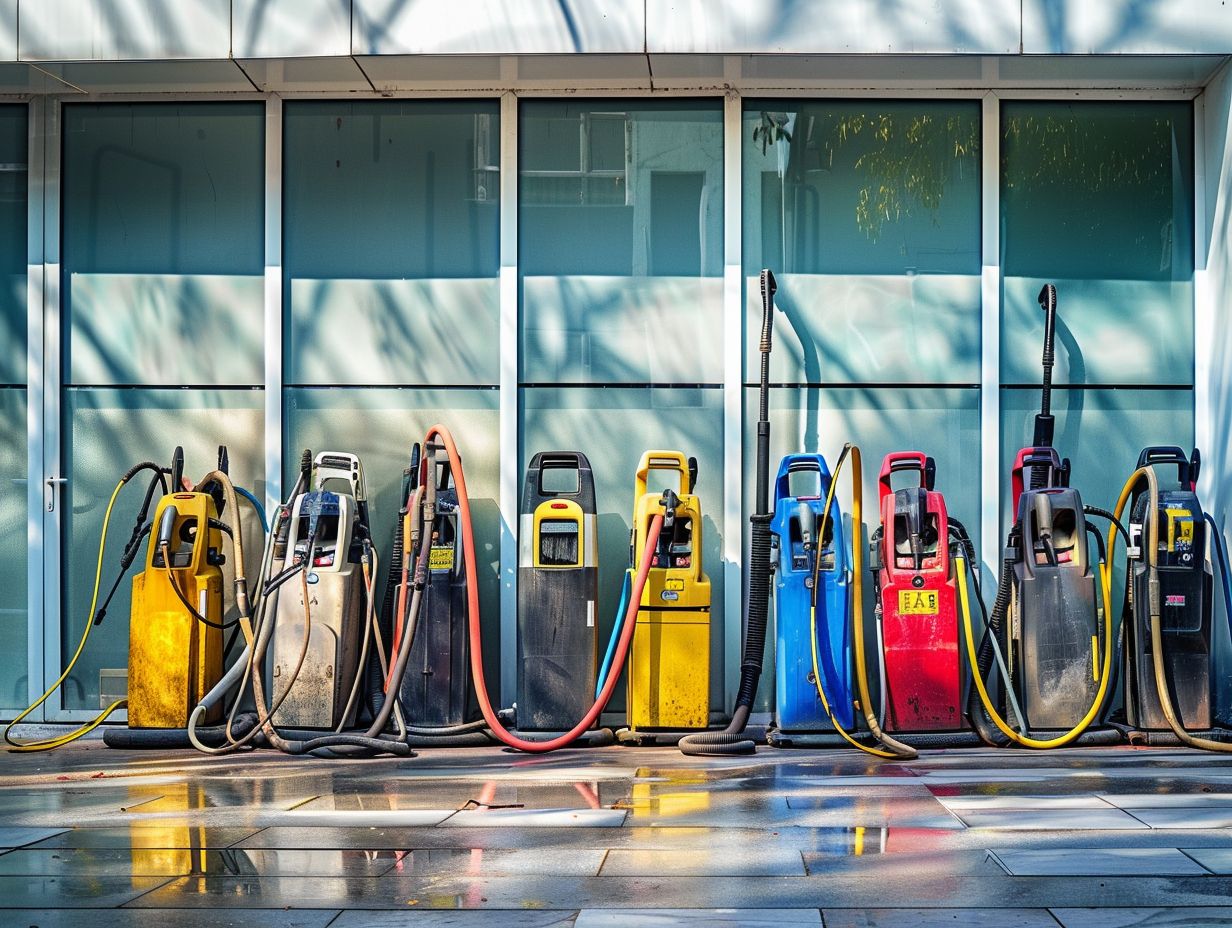
Pressure washers are high-powered cleaning tools used for various cleaning and maintenance tasks, particularly for exterior surfaces. They are designed to efficiently remove tough stains, mold, mildew, dirt, grime, and rust from a wide range of surfaces.
These versatile machines can be adjusted to deliver different pressure levels and water flow rates, allowing them to handle both delicate surfaces like wooden decks and robust surfaces like concrete driveways with ease.
Whether you need to refresh the siding of your house, clean your patio furniture, or remove oil stains from your garage floor, a pressure washer is the go-to solution for speedy and thorough cleaning.
Their effectiveness in saving time and effort makes them a valuable addition to any homeowner’s toolkit.
Why Are Pressure Washers Useful for Cleaning Exterior Facades?
Pressure washers are highly useful for cleaning exterior facades due to their high-powered water pressure and nozzle types that make them effective in removing tough stains, dirt, and grime from various surfaces.
The high pressure generated by pressure washers helps to dislodge stubborn dirt particles that traditional cleaning methods may struggle to tackle effectively. In addition, the different nozzle types available for pressure washers allow users to adjust the spray pattern, making it easier to target specific areas and apply the right amount of pressure for optimal cleaning results. Whether it’s removing algae buildup on a deck or blasting away years of grime from a brick wall, pressure washers prove to be versatile tools for rejuvenating exterior surfaces.
What Are the Different Types of Pressure Washers?
Pressure washers come in various types, including electric pressure washers and gas-powered pressure washers, each offering different cleaning speeds and efficiency levels tailored for specific tasks and surfaces.
Electric pressure washers are popular for their ease of use and portability, making them ideal for light to medium-duty tasks like cleaning cars, patio furniture, and decks. They are quieter and more environmentally friendly than gas-powered models.
On the other hand, gas-powered pressure washers are known for their power and ability to tackle tough, heavy-duty jobs such as removing deep-seated stains, stripping paint, and cleaning large outdoor areas efficiently.
Electric Pressure Washers
Electric pressure washers are popular for their versatility in surface compatibility, making them suitable for a wide range of cleaning tasks. Their portable design adds to their convenience and ease of use.
One of the key advantages of electric pressure washers is their ability to effectively clean various surfaces such as decks, patios, driveways, siding, and vehicles without causing damage. Due to their adjustable pressure settings, these washers can tackle delicate surfaces like wood and glass, as well as tougher materials like concrete and metal. This versatility makes them ideal for home use as well as for commercial applications such as cleaning outdoor furniture, preparing surfaces for painting, and washing vehicles with precision.
Gas-Powered Pressure Washers
Gas-powered pressure washers are known for their heavy-duty performance and high-powered cleaning capabilities, making them ideal for tackling tough stains, grime, and dirt on a larger scale.
These robust machines are especially effective in scenarios where surfaces require deep cleaning, such as driveways covered in oil stains or heavily soiled decks. Their strong water pressure combined with the ability to use hot water or detergent makes them perfect for removing stubborn contaminants. Gas-powered pressure washers are great for large outdoor spaces like patios, fences, and sidings, providing a quick and efficient solution to dirt buildup that would be challenging for regular cleaning methods to handle.
Diesel-Powered Pressure Washers
Diesel-powered pressure washers are designed for high cleaning speeds and exceptional efficiency, making them suitable for professional cleaning tasks that require quick and thorough results.
These robust machines are ideal for scenarios such as cleaning large outdoor areas like parking lots, construction sites, and industrial facilities where heavy dirt and grime need to be removed swiftly. Their powerful engines deliver higher pressure and water flow rates compared to electric models, enabling them to tackle tough stains and dirt buildup with ease. Diesel pressure washers offer greater mobility and independence as they do not require a constant power source, making them versatile for various remote cleaning jobs.
What Are the Key Features to Consider When Choosing a Pressure Washer?
When selecting a pressure washer, crucial features to consider include the power rating, water pressure levels, nozzle types for various spray patterns, and the availability of detergent options for enhanced cleaning capabilities.
Power rating is a key factor that directly impacts the efficiency of the pressure washer. Higher power ratings usually indicate greater cleaning power, making them suitable for heavy-duty tasks.
Water pressure levels determine the force with which water is sprayed, crucial for removing tough stains. Nozzle types play a vital role in controlling the spray pattern, offering versatility for different surfaces.
The availability of detergent options can further enhance cleaning results by breaking down dirt and grime effectively. It is essential to balance these features to find the ideal pressure washer for your specific cleaning needs.
Pressure Rating
The pressure rating of a pressure washer indicates the force at which water is expelled, influencing the cleaning speed and efficiency of the equipment in removing dirt and grime from various surfaces.
Higher pressure ratings, like 3000-4000 PSI, are ideal for tackling tough, deep-seated stains on concrete surfaces or heavy-duty cleaning tasks such as stripping paint. For general household use or washing cars, a pressure washer with a pressure rating of around 1500-2000 PSI would suffice. It’s important to match the pressure rating to the cleaning task at hand to achieve optimal results without causing damage to the surface being cleaned.
Water Flow Rate
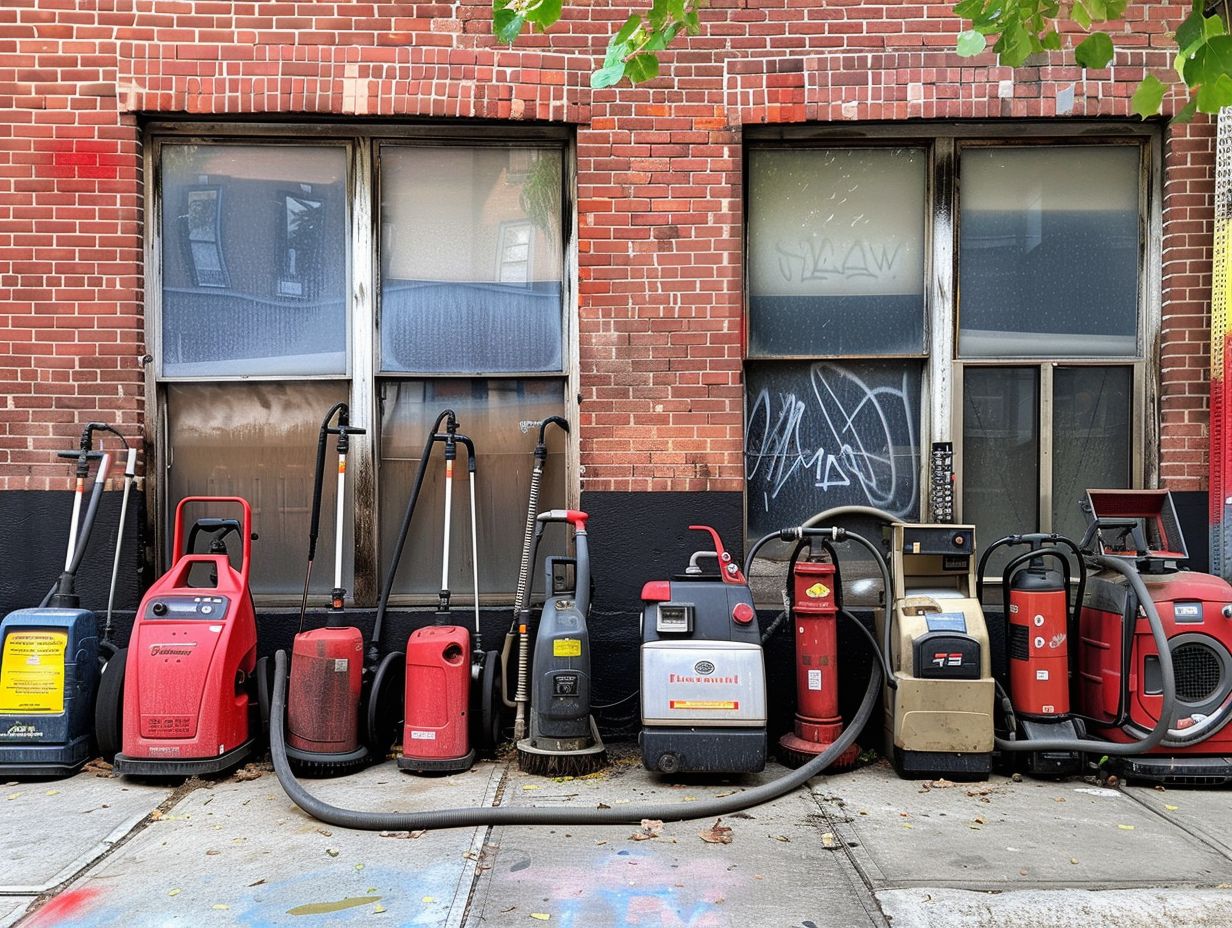
The water flow rate of a pressure washer, combined with suitable nozzle attachments, determines the surface compatibility and the effectiveness of the cleaning process, ensuring thorough dirt removal and efficiency.
Water flow rate and nozzle attachments are crucial factors to consider when using a pressure washer. A higher water flow rate can help in tackling tougher stains and larger surface areas more effectively. On the other hand, selecting the right nozzle attachment is essential for controlling the water flow and pressure, allowing for precision cleaning.
Different nozzle types offer varying spray patterns from wide angles for general washing to narrow streams for focused cleaning. Understanding the specific cleaning task at hand will guide you in choosing the ideal combination of water flow rate and nozzle attachment for optimal results.
Power Source
The power source of a pressure washer, whether gas-powered or electric, influences its portability, cleaning power, and suitability for different tasks, catering to both residential and commercial cleaning needs.
Gas-powered pressure washers are known for their high power output, making them ideal for heavy-duty cleaning tasks such as removing stubborn dirt, grease, and grime from large surface areas. They tend to be heavier and bulkier than electric models, which can impact their maneuverability and ease of use, especially in tight or confined spaces.
On the other hand, electric pressure washers are more lightweight, compact, and easier to store, making them a convenient option for smaller residential tasks and areas that require frequent cleaning maintenance.
Portability
Portability is a vital feature to consider in pressure washers, with factors like hose length and user-friendly design playing crucial roles in enhancing mobility, ease of operation, and accessibility for various cleaning tasks.
Long hoses allow users to reach distant areas without constantly moving the machine, while swivel connectors and ergonomic handles provide added convenience during extended use.
Some popular portable models that exemplify user-friendly designs include the Karcher K5 Premium Electric Pressure Washer and the Sun Joe SPX3000 Pressure Washer, both known for their compact size, lightweight construction, and intuitive controls that make them easy to maneuver around tight spaces.
Nozzle Attachments
The nozzle attachments of a pressure washer determine the spray patterns and water dispersion, influencing the dirt removal efficiency and the versatility of the equipment in handling various cleaning tasks on different surfaces.
Different nozzle types, such as 0-degree, 15-degree, 25-degree, 40-degree, and soap nozzles, offer specific benefits. For instance, 0-degree nozzles provide a concentrated, powerful stream for tough stains, while 40-degree nozzles cover larger areas with a gentler spray. Choosing the right nozzle for the task at hand can significantly impact the cleaning results and prevent damage to delicate surfaces. Understanding the characteristics of each type and their applications is crucial for achieving optimal performance from your pressure washer.
What Are the Safety Precautions for Using Pressure Washers?
When operating pressure washers, it is essential to adhere to safety precautions, such as utilizing built-in safety features and ensuring an ergonomic design that promotes user-friendly handling and minimizes risks during use.
This means always reading the user manual before starting to operate the pressure washer to understand all safety instructions. It is crucial to wear protective gear such as safety goggles and sturdy footwear to protect yourself from potential debris or slippery surfaces. Another important precaution is to never point the pressure washer at yourself or others, as the high-pressure stream of water can cause serious injuries. By following these safety measures and being cautious while using a pressure washer, you can ensure a safe and effective cleaning experience.
Wear Protective Gear
Wearing appropriate protective gear, such as goggles, gloves, and boots, is crucial when using pressure washers to safeguard against potential injuries from high-pressure water and cleaning agents.
-
Goggles are essential to shield the eyes from splashes and debris that may be propelled by the high-pressure water.
-
Sturdy gloves are necessary to protect the hands from the force of the water jet and potential contact with harsh chemicals.
-
Wearing boots with good traction helps prevent slips and provides ankle support.
For different cleaning tasks, such as car washing or cleaning concrete surfaces, consider using specialized gear like chemical-resistant gloves for handling detergents and waterproof aprons for protection against overspray.
Use Proper Technique
Employing the correct cleaning technique, including maintaining an optimal distance from the surface and using appropriate nozzle settings, ensures efficient cleaning, high performance, and minimizes the risk of damage during pressure washer operation.
By controlling the distance between the nozzle and the surface being cleaned, you prevent potential damage while still effectively removing dirt and grime. Adjusting the nozzle to different spray patterns can optimize the cleaning process for various surfaces; for example, a narrow spray may be suitable for tough stains, while a wider spray is gentler for delicate surfaces. Mastering the art of maneuvering the pressure washer smoothly and steadily across the surface can result in a thorough and streak-free clean, enhancing the overall appearance of your outdoor spaces.
Avoid Using on Fragile Surfaces
It is crucial to avoid using pressure washers on fragile surfaces like delicate wood or painted areas to prevent damage or stripping of finishes, ensuring the equipment’s suitability for effectively removing tough stains without causing harm.
Identifying surfaces that are susceptible to damage from pressure washing is key in maintaining the integrity and aesthetics of your property. Surfaces such as historic brickwork, soft stone like limestone or sandstone, and delicate stucco finishes require special care.
Instead of using a pressure washer, consider gentler cleaning methods such as hand scrubbing with mild soap and water, or using a soft-bristle brush. For outdoor wooden furniture, opt for a wood cleaner and a gentle scrubbing brush to avoid any potential damage.
How Can Pressure Washers Be Used for Different Types of Exterior Facades?
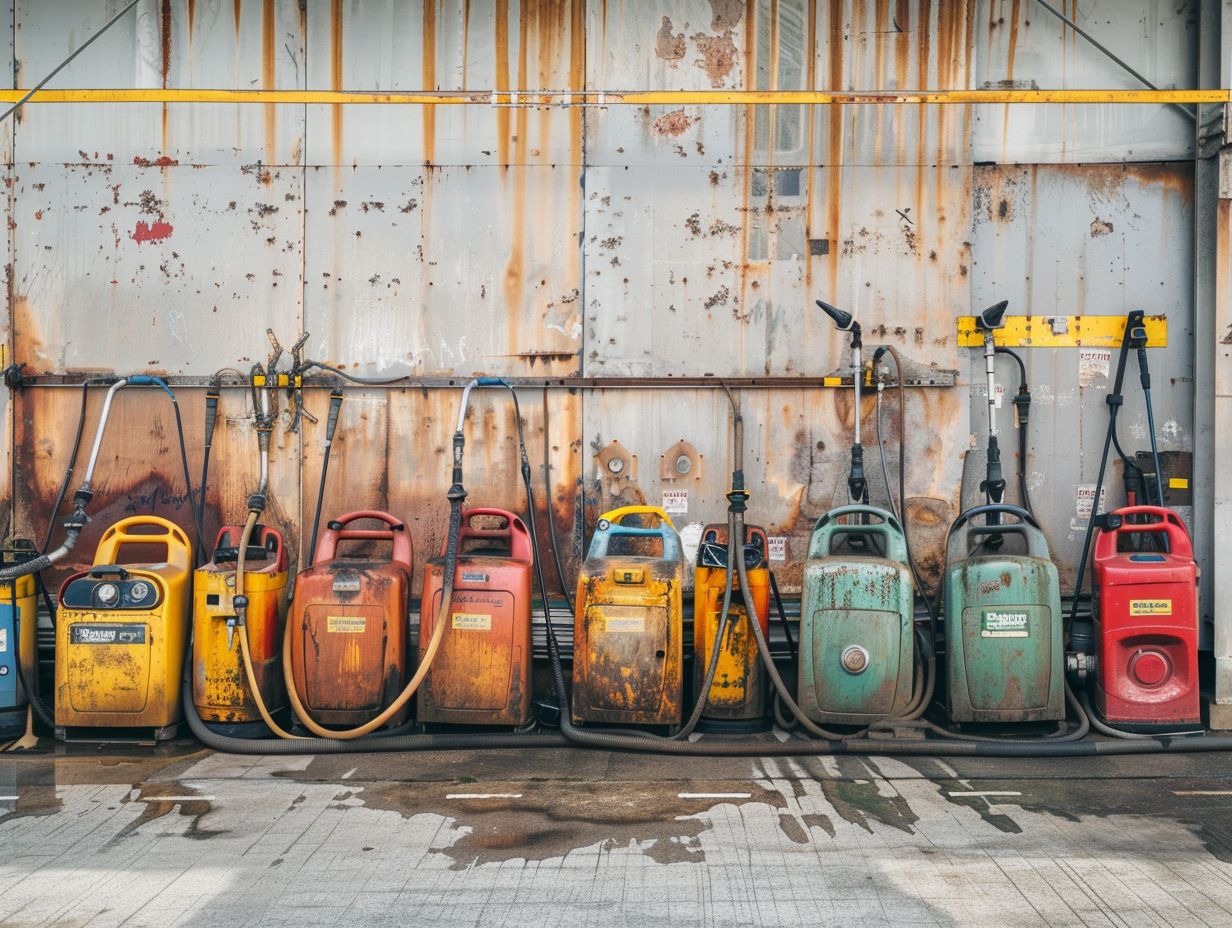
Pressure washers offer versatile cleaning solutions for various exterior surfaces, including brick, concrete, wood, siding, driveways, patios, decks, vehicles, and outdoor furniture, effectively removing dirt, grime, and stains.
With their adjustable pressure settings and various nozzle options, pressure washers can be tailored to suit different surface materials. For instance, when cleaning brick exteriors, using a wider spray pattern at a lower pressure can prevent damage to the mortar. For concrete surfaces, a higher pressure setting may be more effective in lifting stubborn grime. Wood surfaces require caution, as excessive pressure can cause splintering; it’s advisable to start with a lower pressure level and gradually increase if needed.
Brick and Stone
Pressure washers are ideal for cleaning brick and stone facades, removing tough stains, mold, and mildew effectively without causing damage to the surfaces, providing a renewed appearance with minimal effort.
The high-pressure water stream can reach into the porous surfaces of bricks and stones, dislodging dirt and grime that might be deeply embedded. This cleaning method not only saves time but also ensures a thorough and even cleaning outcome. It is important to adjust the pressure settings carefully based on the surface material to prevent any potential damage. Using appropriate cleaning solutions in conjunction with the pressure washer can boost the removal of stubborn stains and enhance the overall cleaning effectiveness.
Wood
Pressure washers can be used on wood surfaces, including siding, decks, and outdoor furniture, to remove dirt and grime, revitalizing the appearance of wooden structures and furnishings with ease and efficiency.
When using a pressure washer on wood, it’s crucial to select the appropriate nozzle tip and adjust the pressure to prevent damage. For siding, a wide-angle tip can help clean without causing harm. When cleaning decks and outdoor furniture, it’s recommended to start at a lower pressure setting and gradually increase as needed. To maintain the beauty of wood, it’s essential to follow up pressure washing with proper drying to prevent mold and mildew growth.
Applying a wood sealant or stain after cleaning can help protect and enhance the wood’s longevity and aesthetics.
Vinyl
When cleaning vinyl and stucco exteriors, pressure washers are effective in removing rust and grime, providing rapid cleaning results with the right pressure levels and nozzle attachments for efficient performance.
This powerful cleaning tool is particularly beneficial for tackling stubborn rust stains on these types of surfaces, with its high-pressure water jets making quick work of even the toughest dirt.
To achieve optimal results, it is essential to choose the appropriate pressure level based on the surface material – lower pressure for vinyl and higher pressure for stucco. Selecting the right nozzle, such as a wide fan tip for larger surface areas or a pinpoint tip for precision cleaning, can further enhance the effectiveness of the pressure washer on vinyl and stucco facades.
Concrete
Concrete surfaces like driveways and patios benefit from pressure washers’ ability to tackle tough stains and grime effectively, especially when using appropriate detergent options to enhance cleaning results and restore the concrete’s appearance.
The high pressure of the water stream generated by pressure washers can penetrate deep into the porous surface of concrete, lifting away dirt and mildew that can accumulate over time. Using specialized concrete detergents can help break down oil stains and embedded debris more efficiently. To achieve optimal cleaning outcomes, it is recommended to start with a lower pressure setting to prevent damage and then gradually increase the pressure as needed. Consistent and thorough cleaning with a pressure washer can prolong the lifespan of concrete surfaces and improve overall curb appeal.
Stucco
Stucco exteriors can be effectively cleaned using pressure washers to remove mold, mildew, dirt, and grime buildup, restoring the stucco surface to its original condition with efficient dirt removal and enhanced exterior appearance.
One of the key benefits of pressure washing stucco facades is the ability to tackle stubborn mold and mildew, which can not only detract from the visual appeal of a property but also pose potential health risks.
By using a pressure washer with the appropriate attachments and cleaning solutions, you can effectively eliminate these unsightly and harmful contaminants.
It’s crucial to exercise caution when pressure washing stucco to prevent damage. Adjusting the pressure settings, using the correct nozzle, and maintaining a safe distance from the surface are essential steps to ensure a thorough clean without causing harm to the stucco material.
What Are Some Tips for Maintaining and Storing Pressure Washers?
Proper maintenance and storage practices are essential for prolonging the durability and longevity of pressure washers. Regular cleaning after use, storing in a dry place, and performing routine maintenance checks can enhance the equipment’s performance and longevity.
After each use, it is crucial to remove any leftover detergent or debris from the washer’s nozzles and hoses to prevent clogs and damage. Running a mixture of water and vinegar through the system can help eliminate mineral buildup.
When it comes to storage, ensure that the pressure washer is stored in a secure and covered area to protect it from dust, moisture, and extreme temperatures. Checking the pump oil levels regularly and replacing any worn-out parts promptly are also vital maintenance tasks to keep your pressure washer in top condition.
Clean After Every Use
Cleaning the pressure washer after each use is crucial for preventing clogs, maintaining efficiency, and prolonging the equipment’s lifespan by removing dirt and debris that can affect performance.
Neglecting the cleaning of your pressure washer can lead to blockages in the nozzles, hoses, and pump, which in turn can reduce its effectiveness and even cause damage. To keep your pressure washer running smoothly, it is recommended to follow a simple, yet essential, cleaning routine.
- Start by disconnecting the power source and water supply before removing any attachments.
- Next, clear out any remaining detergent or chemicals.
- Then, use a mixture of mild soap and water to clean the exterior, hose, and nozzles thoroughly.
- Rinse the washer with clean water and allow all parts to air dry completely before storage.
Performing these cleaning steps after each use will ensure that your pressure washer operates at its best and has a longer lifespan.
Store in a Dry Place
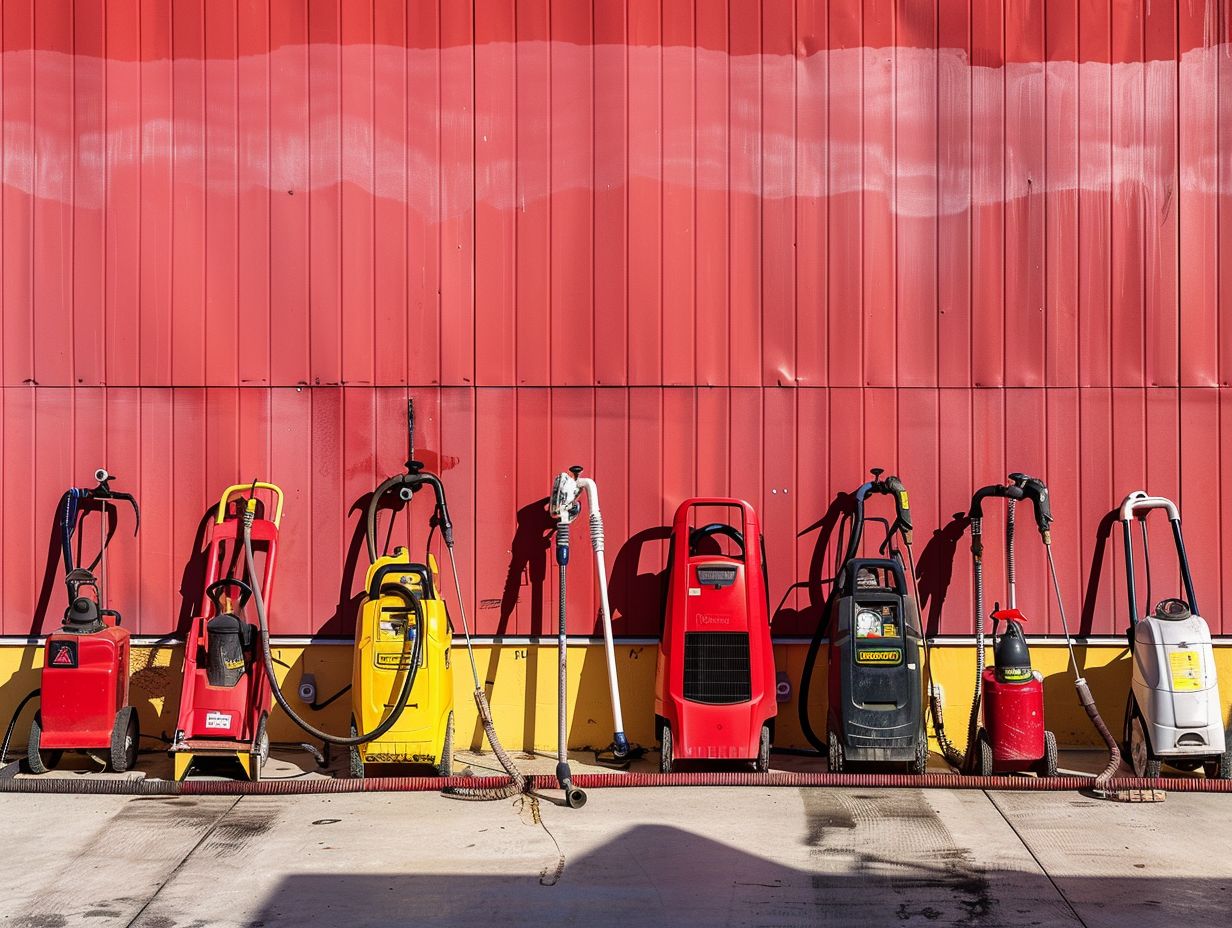
Storing the pressure washer in a dry place, away from moisture and harsh elements, is essential for maintaining its longevity and preventing rust formation that can compromise the equipment’s functionality over time.
Choosing the right storage location plays a crucial role in ensuring the pressure washer remains in optimal condition. A garage or shed are excellent choices as they provide shelter from the elements. It’s advisable to cover the pressure washer with a waterproof tarp or a specially designed cover to shield it from dust and debris. Storing the washer on a raised platform or shelf can help prevent it from sitting in any accumulating moisture. By taking these protective measures, you can safeguard your equipment and enjoy its reliable performance for years to come.
Perform Regular Maintenance
Regular maintenance checks, including inspecting hoses, nozzles, and connections, are crucial for identifying potential issues early, ensuring the pressure washer’s reliability, and adhering to warranty requirements for extended coverage.
By regularly examining these components, users can prevent leaks, blockages, and other malfunctions that could lead to costly repairs or replacements. It is recommended to clean the nozzles and filters after each use to prevent clogging and maintain optimal performance. Checking for any signs of wear and tear on the hoses and connections can help avoid unexpected breakdowns during operation. Following the manufacturer’s maintenance guidelines also plays a key role in preserving the warranty validity and ensuring that any necessary repairs are covered.
Frequently Asked Questions
What is a pressure washer and why is it important for cleaning exterior facades?
A pressure washer is a powerful cleaning tool that uses a high-pressure spray of water to remove dirt, grime, and other substances from surfaces. It is important for cleaning exterior facades because it can effectively and efficiently clean hard-to-reach areas and remove tough stains.
What should I consider when selecting a high-powered pressure washer for exterior facades?
When selecting a pressure washer for exterior facades, consider the pressure level, flow rate, nozzle types, power source, and portability. These factors will determine the effectiveness and convenience of the pressure washer for your specific needs.
What is the ideal pressure level for cleaning exterior facades?
The ideal pressure level for cleaning exterior facades is between 1500-2500 PSI. This range provides enough power to effectively remove dirt and grime without causing damage to the surface.
What type of nozzle should I use for cleaning exterior facades?
For cleaning exterior facades, a narrow fan or turbo nozzle is recommended. These nozzles provide a concentrated and powerful spray that can effectively remove dirt and grime from the surface.
What power source is best for a high-powered pressure washer for exterior facades?
Gas-powered pressure washers are typically best for exterior facades as they provide more power and mobility compared to electric washers. However, if you have access to a nearby power outlet, an electric pressure washer can also be a suitable option.
Can a high-powered pressure washer damage exterior facades?
Yes, if used incorrectly, a high-powered pressure washer can damage exterior facades. It is important to use the correct pressure level and nozzle type, and to keep a safe distance from the surface to avoid causing any damage. It is also recommended to test a small, inconspicuous area before cleaning the entire facade.




